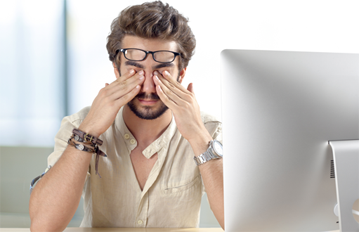
Eyestrain
Anyone who reads for hours, works at a computer, or drives long distances knows about this one. It happens when you overuse your eyes. They get tired and need to rest, just like any other part of your body. If your eyes feel strained, give them some time off. If they're still weary after a few days, check with your doctor to make sure it isn't another problem.

Lazy Eye
Lazy eye, or amblyopia, happens when one eye doesn't develop properly. Vision is weaker in that eye, and it tends to move "lazily" around while the other eye stays put. It's found in infants, children, and adults, and rarely affects both eyes. If in infants and children, treatment needs to be sought immediately. Lifelong vision problems can be avoided if a lazy eye is detected and treated during early childhood. Treatment includes corrective glasses or contact lenses and using a patch or other strategies to make a child use the lazy eye.
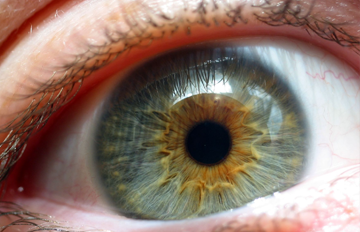
Uveitis
This is the name for a group of diseases that cause inflammation of the uvea. That's the middle layer of the eye that contains most of the blood vessels.
These diseases can destroy eye tissue, and even cause eye loss. People of all ages can have it. Symptoms may go away quickly or last for a long time.
People with immune system conditions like AIDS, rheumatoid arthritis, or ulcerative colitis may be more likely to have uveitis. Symptoms may include:
• Blurred vision,Eye pain,Eye redness,Light sensitivity
See your doctor if you have these symptoms and they don't go away within a few days. There are
different kinds of treatment for uveitis, depending on the type you have.
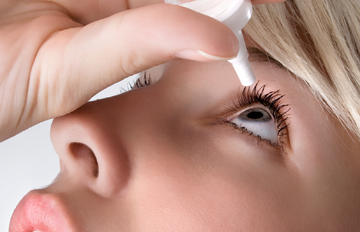
Dry Eyes
This happens when your eyes can't make enough good-quality tears. You might feel like something is in your eye or like it's burning. Rarely, in severe cases, extreme dryness can lead to some loss of
vision. Some treatments include:
• Using a humidifier in your home
• Special eye drops that work like real tears
• Plugs in your tear ducts to lessen drainage
• Lipiflow, a procedure that uses heat and pressure to treat dry eyes
• Testosterone eyelid cream
• Nutritional supplements with fish oil and omega-3
If your dry eye problem is chronic, you may have dry eye disease. You doctor could prescribe medicated drops like cyclosporine (Restasis)
or lifitegrast (Xiidra) to stimulate tear production.
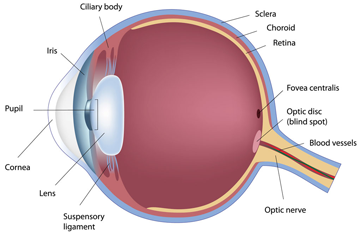
Corneal Diseases
The cornea is the clear, dome-shaped "window" at the front of your eye. It helps to focus the light that comes in.
Disease, infection, injury, and exposure to toxins can damage it. Signs include:
• Red eyes, Watery eyes, Pain, Reduced vision, or a halo effect
The main treatment methods include:
• A new eyeglasses or contacts prescription
• Medicated eye drops
• Surgery

Problems with Contact Lenses
They work well for many people, but you need to take care of them. Wash your hands before you touch them.
Follow the care guidelines that came with your prescription. And follow these rules:
• Never wet them by putting them in your mouth. That can make an infection more likely.
• Make sure your lenses fit properly, so they don't scratch your eyes.
• Use eye drops that say they're safe for contact lenses.
• Never use homemade saline solutions. They aren't sterile and could cause an infection.
• Don't sleep with them in. Doing so raises the risk of infection.
If you do everything right and still have problems with your contacts, see your eye doctor. You might have allergies, dry eyes, or just be better off with glasses. Once you know what the problem is, you can decide what's best for you.

Eye floaters
Eye floaters are tiny specks or strings that float into your field of vision. While they may be a nuisance, eye floaters should not cause you any pain or discomfort. Eye floaters can appear as black or gray dots, lines, cobwebs, or blobs. Occasionally, a large floater may cast a shadow over your vision and cause a large, dark spot in your sight. Because the floaters are inside the fluid of your eye, they will move as your eyes move. If you try to look right at them, they will dart out of your vision. Eye floaters commonly appear when you stare at a bright, plain surface, such as the sky, a reflective object, or blank paper. Eye floaters may be present in only one eye, or they may be in both.

Visual disturbances
Visual disturbances interfere with normal sight. The various types of visual disturbances may be caused by several conditions and disorders. Some are temporary and can be relieved with treatment.
However, some can be permanent.
Types of visual disturbances
The most common visual disturbances include:
• double vision, or diplopia, partial or total blindness, colour-blindness, blurred vision, halos, pain
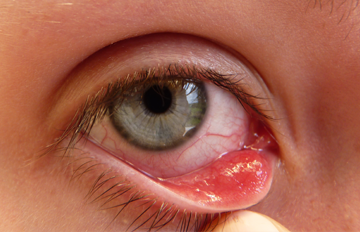
Eyelid Turned In (Entropion)
Entropion refers to a condition in which your eyelid rotates inward. Your eyelashes rub against your eye and cause redness, irritation, and abrasions on the cornea of your eye. Entropion, or eyelid retraction, develops slowly and may not be noticeable in its early stages. Over time, however, the condition worsens until every movement of the eye irritates the surface of the cornea. Without treatment, this continuous abrasion can cause eye infections and scarring of the eyeball. With a serious case, you can lose sight in the affected eye.
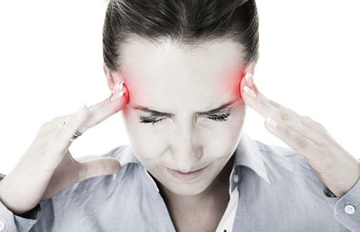
Ocular Migraines
1. Bright lights, loud sounds, and powerful odors are common triggers of ocular migraines.
2. A family history of migraine or ocular migraine increases your chances of having them.
3. Migraines have been linked to the hormone estrogen.
A migraine that involves visual disturbance is called an ocular migraine. Ocular migraines can develop with or without the accompanying pain of a classic migraine.
During an ocular migraine, or migraine with aura, you may see flashing or shimmering lights, zigzagging lines, or stars. Some people describe psychedelic images. It may also cause blind spots in your field of vision. Of people who report having migraines, one out of every five experiences this aura.
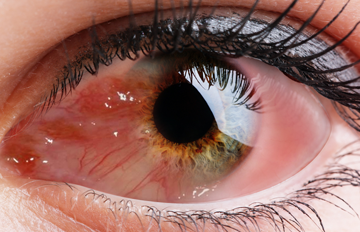
Red Eyes
Your eyes look bloodshot. Why? Their surface is covered in blood vessels that expand when they're irritated or infected. That gives your eyes the red look. Eyestrain can do it, and so can a late night, a lack of sleep, or allergies. If an injury is the cause, get it checked by your doctor. Red eyes could be a symptom of another eye condition, like conjunctivitis (pinkeye) or sun damage from not wearing shades over the years. If over-the-counter eye drops and rest don't clear it up, see your doctor.
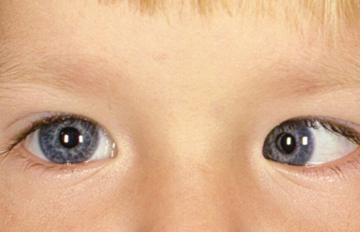
Cross Eyes (Strabismus) and Nystagmus
If your eyes aren't lined up with each other when you look at something, you could have strabismus You might also hear it called crossed eyes or walleye. This problem won't go away on its own. You'll need to get an ophthalmologist, or eye specialist, to correct it.With nystagmus, the eye moves all the time on its own. You have no control.

Presbyopia
This happens when you lose the ability, despite good distance vision, to clearly see close objects and small print.After age 40 or so, you may have to hold a book or other reading material farther away from your eyes to make it easier to read. Sort of like your arms are too short.
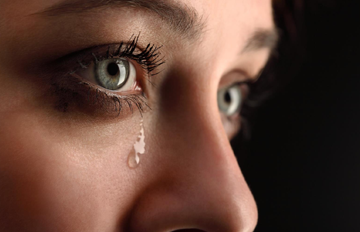
Excess Tearing
It has nothing to do with your feelings. You might be sensitive to light, wind, or temperature changes.Try to protect your eyes by shielding them or wearing sunglasses (go for wraparound frames – they block more wind than other types).Tearing may also signal a more serious problem, like an eye infection or a blocked tear duct. Your eye doctor can treat or correct both of these conditions.
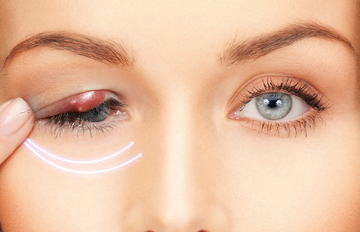
Eyelid Problems
Your eyelids do a lot for you. They protect your eye, spread tears over its surface, and limit the amount of light that can get in. Pain, itching, tearing, and sensitivity to light are common symptoms of eyelid problems. You might also have blinking spasms or inflamed outer edges near your eyelashes. Treatment could include proper cleaning, medication, or surgery.
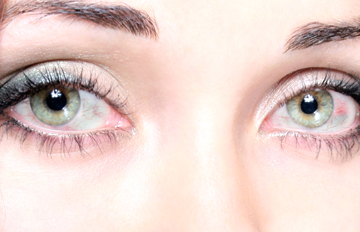
Allergic conjunctivitis
When your eyes are exposed to substances like pollen or mold spores, they may become red, itchy, and watery. These are symptoms of allergic conjunctivitis. Allergic conjunctivitis is an eye inflammation caused by an allergic reaction to substances like pollen or mold spores. The inside of your eyelids and the covering of your eyeball have a membrane called the conjunctiva. The conjunctiva is susceptible to irritation from allergens, especially during hay fever season. Allergic conjunctivitis is quite common. It's your body's reaction to substances it considers potentially harmful.

Corneal abrasion
The cornea is a thin, transparent dome that covers your eye's iris and pupil. The iris is the coloured part of your eye, and the pupil is the black center. All light that enters your eye and allows you to see Strikes your cornea first. Flying dust, specks of metal, grains of sand, a fingernail, an animal claw, or other foreign objects can scratch your cornea. Contact lenses can also scratch or irritate your cornea. A minor scratch is called a corneal abrasion. Most corneal abrasions are minor and heal quickly. Sometimes a corneal abrasion is accompanied by inflammation in your eye. This is called iritis. An infected corneal abrasion can also become a corneal ulcer. These are serious conditions that can develop from a corneal abrasion.
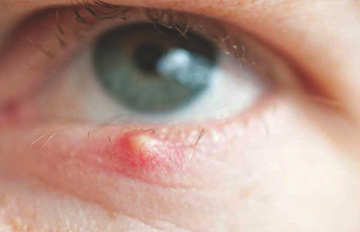
Eyelid Bump
Eyelid bumps appear as painful, red lumps at the edge of the eyelid, typically where the lash meets the lid.
Bacteria or a blockage in the oil glands of the eyelid causes most eyelid bumps.
1. Three kinds of eyelid bumps are styes, chalazia, or xanthelasma.
2. Most eyelid bumps go away on their own with home treatment, but see your doctor if they continue to grow, affect your vision, or show symptoms of infection, such as discharge.
3. Effective home treatments for eyelid bumps include applying a warm compress several times per day to the infected eye and refraining from wearing eye makeup or contact lenses.
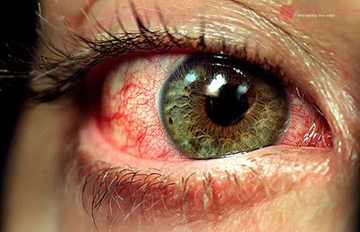
Eye burning sensation
If you have a burning sensation in your eye and it's accompanied by itchiness and discharge, chances are you have an infection. These symptoms can also be a sign that you have an eye injury or a foreign object in your eye, or allergies. Symptoms can be serious and leaving your eye untreated can increase your risk of eye damage or loss of sight. Read on to learn more about causes, symptoms, treatments, and prevention.
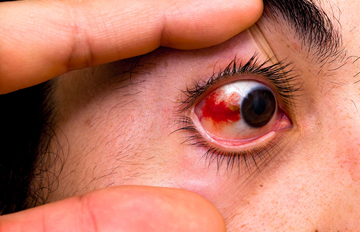
Eye Emergency
An eye emergency occurs any time you have a foreign object or chemicals in your eye, or when an injury or burn affects your eye area. Remember, you should seek medical attention if you ever experience swelling, redness, or pain in your eyes. Without proper treatment, eye damage can lead to a partial loss of vision or even permanent blindness.
Sarcoidosis
sarcoidosis is an inflammatory disease in which granulomas, or clumps of inflammatory cells, form in various organs. This causes organ inflammation. Sarcoidosis may be triggered by your body's immune system responding to foreign substances, such as viruses, bacteria, or chemicals.

Pterygium
A pterygium is a growth that develops on the conjunctiva or mucous membrane that covers the white part of your eye. It's a benign or noncancerous growth that's often shaped like a wedge. In some cases, a pterygium can extend to the cornea. This is the clear part of your eye that covers your iris and pupil. A pterygium usually doesn't cause problems or require treatment, but it can be removed if it interferes with your vision.
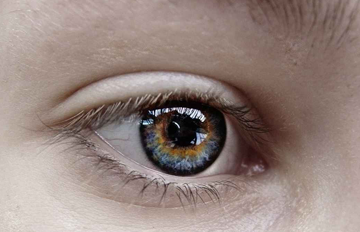
Night Blindness
Is it hard to see at night, especially while driving? Is it tough to find your way around in in dark places, like movie theaters? That sounds like night blindness. It's a symptom, not a problem in its own right. Nearsightedness, cataracts, keratoconus, and a lack of vitamin A all cause a type of night blindness that doctors can fix. But some people are born with this problem or it might develop from a degenerative disease involving the retina, and that usually can't be treated. If you have it, you'll need to be extra careful in areas of low light.

Colour-blindness
When you can't see certain colours, or can't tell the difference between them (usually reds andgreens), you may be colour-blind. It happens when the colour cells in your eye (the doctor will call them cone cells) are absent or don't work.When it's most severe, you can only see in shades of gray, but this is rare. Most people who have it are born with it, but you can get it later in life from certain drugs and diseases. Your doctor can tell you what's to blame. Men are much more likely to be born with it than women. Your eye doctor can diagnose it with a simple test. There's no treatment if you're born with it, but special contacts and glasses can help some people tell the difference between certain colours.
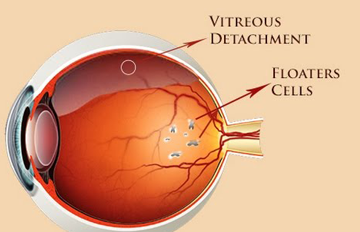
Floaters
These are tiny spots or specks that float across your field of vision. Most people notice them in well-lit rooms or outdoors on a bright day.Floaters are usually normal, but they sometimes can be a sign of a more serious eye problem, like retinal detachment. That's when the retina at the back of your eye separates from the layer underneath. When this happens, you might also see light flashes along with the floaters or a dark shadow come across the edge of your sight. If you notice a sudden change in the type or number of spots or flashes you see or a new dark "curtain" in your peripheral vision, go to your eye doctor as soon as possible.
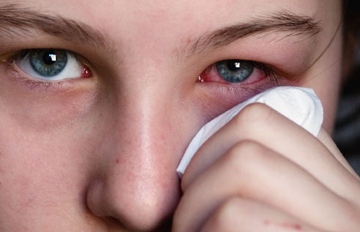
Conjunctivitis (Pinkeye)
In this condition, tissue that lines the back of your eyelids and covers your sclera gets inflamed. It can cause redness, itching, burning, tearing, discharge, or a feeling that something is in your eye. People of all ages can get it. Causes include infection, exposure to chemicals and irritants, or allergies. Wash your hands often to lower your chance of getting it.
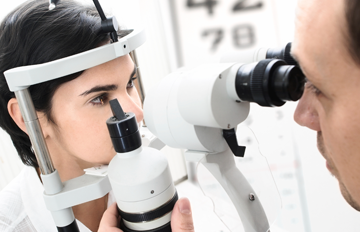
Vision Changes
As you get older, you may find that you can't see as well as you once did. That's normal. You'll probably need glasses or contacts. You may choose to have surgery (LASIK) to correct your vision. If you already have glasses, you may need a stronger prescription. Other, more serious conditions also happen as you age. Eye diseases like macular degeneration, glaucoma, and cataracts, can cause vision problems. Symptoms vary a lot among these disorders, so keep up with your eye exams. Some vision changes can be dangerous and need immediate medical care. Anytime you have a Sudden loss of vision, or everything looks blurry -- even if it's temporary -- see a doctor right away. Go to the emergency room or call 911.

Foreign object in the eye
1. A foreign object in the eye is something that enters the eye from outside of the body. It can be anything from a dust particle to a metal shard.
2. The foreign object will most likely affect the cornea or the conjunctiva. The cornea is the protective covering of the front of the eye, and the conjunctiva is the mucous membrane that covers the white of the eye.
3. Go to the emergency room if a foreign object is embedded in your eye. Do not attempt to remove it yourself.
A foreign object in the eye is something that enters the eye from outside the body. It can be anything that does not naturally belong there, from a particle of dust to a metal shard. When a foreign object
enters the eye, it will most likely affect the cornea or the conjunctiva. The cornea is a clear dome that covers the front surface of the eye. It serves as a protective covering
for the front of the eye. Light enters the eye through the cornea. It also helps focus light on the retina at the back of the eye. The conjunctiva is the thin mucous membrane that covers the sclera, or the white of the eye. The
conjunctiva runs to the edge of the cornea. It also covers the moist area under the eyelids. A foreign object that lands on the front part of the eye cannot get lost behind the eyeball, but they can
cause scratches on the cornea. These injuries usually are minor. However, some types of foreign objects can cause infection or damage your vision.
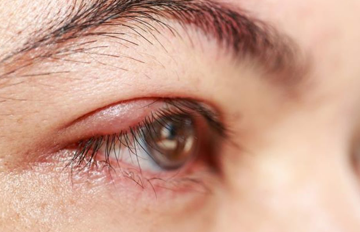
Eyelid Inflammation (Blepharitis)
Your eyelids are the folds of skin that cover your eyes and protect them from debris and injury. Your eyelids also have lashes with short, curved hair follicles on the edge of the lids. These follicles contain oil glands. These oil glands can sometimes become clogged or irritated, which triggers inflammation. This condition is known as eyelid inflammation, or blepharitis. There are two types of eyelid inflammation: anterior and posterior. Washing your eyes and applying a warm compress can reduce inflammation Rubbing your eyes can spread an existing infection

Eye pain
Eye pain is also known as ophthalmalgia. Depending on where you experience the discomfort, eye pain can fall into one of two categories. Ocular pain occurs on the eye's surface, and orbital pain occurs within the eye. Eye pain is common, but it's rarely a symptom of a serious condition. Most often, the pain resolves without medicine or treatment. Eye pain that occurs on the surface may be a scratching, burning, or itching sensation. Surface pain is usually caused by irritation from a foreign object, infection, or trauma. Often, this type of eye pain is easily treated with eye drops or rest.Eye pain that occurs deeper within the eye may feel aching, gritty, stabbing, or throbbing. This kind of eye pain may require more in-depth treatment.
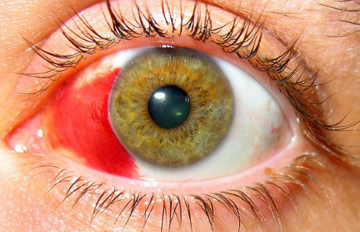
Bleeding Under the Conjunctiva
The transparent tissue that covers your eye is called the conjunctiva. When blood collects under this transparent tissue, it's known as bleeding under the conjunctiva, or subconjunctival hemorrhage.
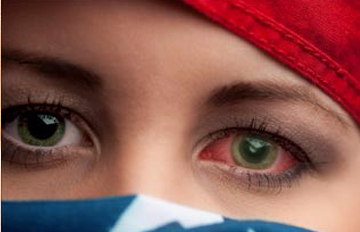
Corneal Ulcer
At the front of the eye is a clear layer of tissue called the cornea. The cornea is the window of your eye and permits light to enter the eye. Tears defend the cornea against bacteria, viruses, and fungi. A corneal ulcer is an open sore that forms on the cornea. It's usually caused by an infection. Even small injuries to the eye or erosion caused by wearing contact lenses too long can lead to infections.

 Dr Jacob's
Dr Jacob's  Book Now
Book Now